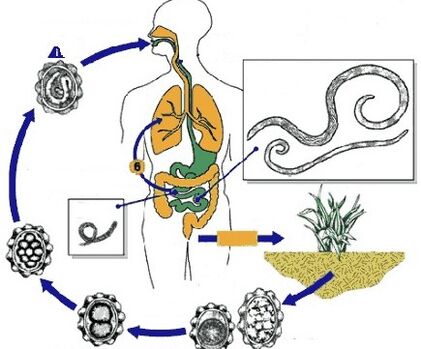
Helminthiases are a group of parasitic diseases that progress due to the penetration of various types of parasitic worms into the body. These diseases are not limited in terms of sex and age. It is worth noting that helminthiasis is most often diagnosed in children. This is due to the fact that children are less hygienic, eat unwashed food and often play outdoors (sandpit, garden, etc. ).
Helminths are a group of representatives of lower worms that are able to penetrate the human body and develop freely in it, thereby provoking the progression of parasitic ailments. All representatives of this group can be conditionally divided into 3 groups:
- nematodes;
- tape;
- flukes.
Depending on the mode of transmission, all human helminthiases are divided into:
- biohelminthiasis.In this case, the parasite is carried by animals;
- contagious.Infection occurs from a sick person;
- geohelminthiasis.This type of helminthiasis is transmitted through the soil. This is due to the fact that a certain part of the pest's life cycle takes place right in the soil.
Larval and developing forms of parasites are the most dangerous for the human body, as they can move freely in the body, infect vital organs. Adults cannot move as freely and therefore have a more stable position.
Most types of helminths "prefer" to parasitize in the gastrointestinal tract. It is worth noting that different species are localized in different parts of the digestive tract: pinworms - in the lower part of the small intestine, nematodes - in its upper part, and so on. Also, according to the location, helminths are divided into tissue and luminal.
It should be noted that parasites can infect not only the digestive tract, but also the lungs, bile ducts and the gallbladder itself. In the course of their life they release various toxic substances that poison the human body. It is important, if you suspect the presence of parasites in the body, immediately consult a doctor and start treating the disease in order to avoid the development of dangerous complications.
Signs

The characteristic signs of helminthiasis appear first of all from the peripheral blood. If you conduct a clinical analysis, you can find a significant increase in the number of eosinophils (especially in the acute stage of the disease). It should be noted that eosinophilia is often associated with severe leukocytosis.
Other signs of helminths include:
- itching in the anus;
- unstable stools are possible - alternation of constipation and diarrhea;
- grinding your teeth in your sleep;
- morning sickness. Most often it occurs in a person while brushing their teeth;
- weight loss while diet did not change;
- hyperthermia, accompanied by joint and muscle pain;
- drooling in the morning;
- a person is constantly hungry;
- the appearance of elements of a rash (sometimes on the eyelids);
- The skin on the fingers may flake off.
Symptoms
The helminthiasis clinic is divided into acute and chronic phases. The first symptoms of helminthiasis appear a month after the penetration of parasites into the body. The acute phase of the pathological process begins. A person experiences the following symptoms:
- diarrhea;
- hyperthermia;
- the upper airways become inflamed;
- elements of a rash appear on the skin;
- conjunctivitis;
- the face swells. This symptom is especially pronounced in children;
- young children sometimes have tonsillitis and lymphadenitis.
The pathological process can be complicated:
- hepatitis;
- bronchospasm;
- the appearance of infiltrates in the lungs;
- pneumonia;
- meningoencephalitis;
- myocarditis.
The above symptoms do not all appear at the same time with any particular type of helminthiasis. Usually in the clinic of the disease only two or three symptoms dominate. Such a clinical picture in a patient is observed for 7 days, after which the disease becomes chronic. The signs of pathology vary depending on the type of pathogen that parasites in the human body:
- echinococcosis. The allergic reaction comes to the fore. Allergy symptoms are at their peak. In the most severe clinical situations, anaphylactic shock may also develop;
- filariasis and strongyloidiasis. The rash on the skin gets worse and the face is swollen.
The manifestation of helminthiasis also largely depends on the location of the parasites. Most parasitic species in the gastrointestinal tract, leading to indigestion, weight loss, nausea, vomiting and intoxication syndrome.
Experts refer to the most severe helminthiasis:
- echinococcosis;
- paragonimiasis;
- cysticercosis.
The indicated helminthiases affect almost all vital organs and systems, therefore, even with timely treatment, the prognosis is often unfavorable.
Diagnostics
Due to the fact that there are a fairly large number of helminthiases, diagnostics include many methods of research. The most informative and frequently used are the following:
- stool analysis. In it, doctors have the opportunity to detect helminth eggs, as well as undigested food debris, which indicate a disruption in the functioning of the gastrointestinal tract;
- blood on microfilariae;
- to detect roundworms and pinworms in the human body, resort to macroscopic examination;
- microscopic examination;
- bile research;
- coproovoscopy. Diagnosis of helminthiasis using this method allows you to determine the intensity of the helminthic invasion;
- examination of the contents of the duodenum;
- if doctors suspect a person is progressing to trichinosis, a muscle tissue biopsy is prescribed;
- ultrasound;
- x-rays;
- fibrogastroduodenoscopy;
- blood test for the presence of specific antibodies against some helminthiases.
Treatment
The main goal of treating the disease is to expel parasites from the patient's body, as well as restore the normal functioning of the gastrointestinal tract. The treatment plan is prescribed only by a qualified specialist after a thorough diagnosis, evaluation of the test results. Treatment can be done both in a hospital setting and at home.
The basis of the treatment of helminthiasis is the use of specific anthelmintic drugs.
They should only be taken as prescribed by the attending physician and in the dosage prescribed by him. In the acute stage of the disease, a single dose of the drug is enough to get rid of helminths. But most often the treatment is carried out according to a certain scheme.
During treatment, it is important to adhere to these principles:
- strict compliance with the rules of personal hygiene;
- diet therapy;
- all consumed products must be processed;
- in the place where the patient is treated, it is necessary to disinfect him regularly.
Treatment of helminthiasis in children is carried out only in stationary conditions, so that the doctor can constantly monitor the patient's condition and, if necessary, adjust therapy. It is worth noting that the disease in children is more severe, so the course of treatment can be long.
Prevention
Prevention of helminthiasis in children and adults should be done throughout life. Since helminths live in the soil and can also be transmitted by contact, hygiene should be observed as much as possible: washing hands, using personal hygiene items, etc. It is also important to carefully process fruits and vegetables before eating them.
For prophylactic purposes, it is important to promptly identify people infected with helminths. To this end, surveys are regularly carried out on certain categories of adults (especially workers in the food sector, the medical sector, etc. ).







































